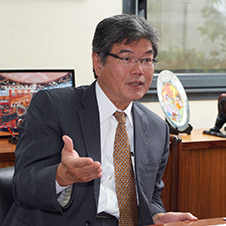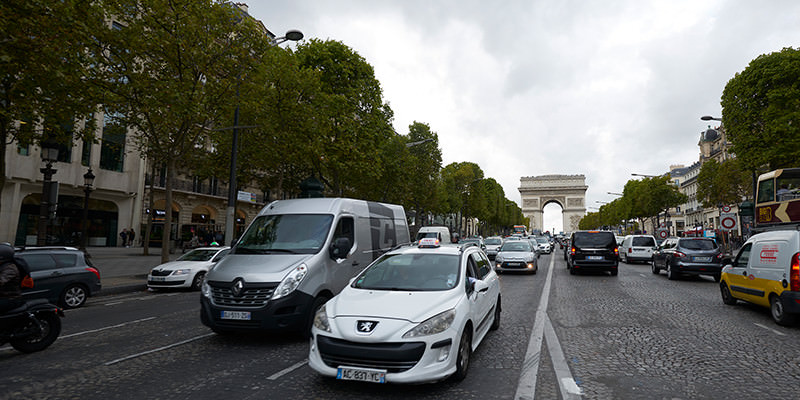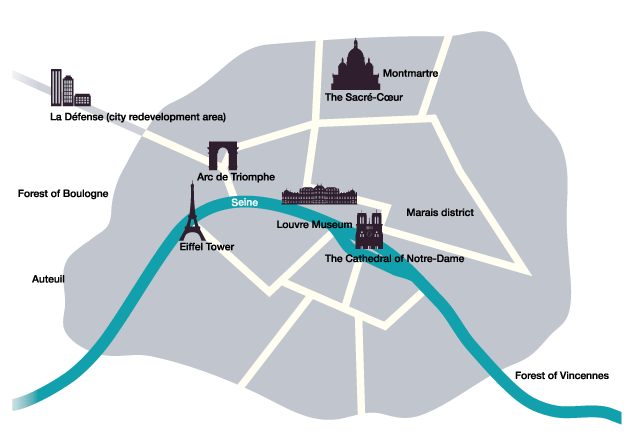05
Mission to Protect the Landscape and Environment of Paris

The city area of Paris includes the urban area inside the loop expressway (area: 86.99 km2. For reference, the area inside the Yamanote Line in Tokyo is 63 km2 and the area of Manhattan in New York City is 59 km2). It was built on the remains of the walls of Thiers castle, as well as the Forest of Boulogne to the west and the Forest of Vincennes to the east. It has a combined area of 105.40 km2.
-

The city of Paris: Step into the city and you will find endless rows of neatly arranged streetscapes. -

People enjoy themselves at cafés throughout Paris.
Kubota's small construction machinery boasts the top market share in Europe

Executive Officer, KUBOTA Corporation
President of KUBOTA EUROPE S.A.S.
While Kubota is known as a manufacturer of tractors, combines and other agricultural machinery, it also manufactures construction machinery such as mini excavators. In Europe, Kubota has three sales companies, KUBOTA BAUMASCHINEN GmbH (KBM), a manufacturing and sales base in Germany, KUBOTA EUROPE S.A.S (KE) in France, and KUBOTA (U.K.) Ltd. (KUK) in the U.K., and has been supplying mini excavators and wheel loaders of eight tons or less to the market through its dealer network.
“Mini excavators supplied by Kubota are highly evaluated in urban civil engineering. They are easy to operate, even in small spaces, but have powerful excavating capability despite their compact size. They also feature a wide range of operations. In the 27 years since its establishment, KBM has worked hard to cultivate customer trust. As with small tractors, KBM has maintained a top market share in Europe, and plans to expend even more energy to promote future sales.” (Nobuyuki Ishii, President of KE)
-

KUBOTA EUROPE S.A.S. (KE) Head Office (Located in Argenteuil, Northwest of Paris).
Kubota construction machinery plays an active role in urban civil engineering. Major European cities such as Paris are full of beautiful scenery. The role of urban civil engineering is to maintain and conserve the landscape of these cities. France is one European country that has been focusing especially on landscape conservation. Let us review French landscape conservation efforts.
Two fundamental landscape conservation laws
In France, the development of systems related to landscape conservation began in 1913, when a policy of historical building conservation was institutionalized. The most epoch-making of the conservation laws was the Malraux Act. Formulated in 1962 by Andre Malraux, who served as the Minister of Culture, this law was designed to complement other legislation relating to the conservation of historical and aesthetic cultural heritage and promote the restoration of real estate. The Malraux Act presented the concept of conservation districts, and it is known as the first law in the world aimed at conserving the historical environment.
In times of rapid modernization, with old towns being demolished nationwide and high-rise buildings going up in the middle of historic urban districts, the main point of the Malraux Act was to revive townscapes by restoring traditional architecture around historic buildings. However, the Malraux Act was revised many times because of its perceived connection to the real estate business. After the “Landscape Law” was enacted in 1993, the Malraux Act gave way to the “POS (Exclusive Land Use Plan),” which was aimed at protecting historic urban districts under the Conservation and Recovery Plan. The POS is still in effect today.
Let us also touch on the Fuseau Regulation, which was enacted in 1977 for the purpose of protecting historical views. A fuseau is a spindle-like cylindrical shape with the middle section bulging. This shape represents the human field of view. Views of monuments are classified into three types based on the Fuseau Regulation, which regulates the height of buildings in front of and behind monuments to prevent obstruction of the view. The Fuseau Regulation currently applies to 47 locations in Paris, and it also serves as the basis for criteria related to building height regulations in other regions.
The origin of the Fuseau Regulation was in the landscape conservation in front of and behind monuments. The Palace of Versailles is a good example. This major tourist attraction covers an enormous area, but you cannot see high-rise buildings from anywhere on the grounds. Such thorough landscape conservation is only possible in France. Planar landscape development in Paris, which started in the restoration projects carried out in historic urban district conservation areas, gradually spread to wider areas until it covered the entire city.
-

Paris, the City of Art: Many artists have lived in Montmartre, including Toulouse- Lautrec. -

Stone-paved street in the landscape and environment conservation area. -

View of the Arc de Triomphe from the Champs-Elysées: Traffic is heavy on the main street of Paris.
Construction machinery that contributes to environmental conservation
In parallel with landscape conservation, environmental protection is an important theme. Environmental problems in urban areas include various elements, but pollution caused by vehicle exhaust emissions is a common challenge for all developed countries. The EU has been imposing strict regulations against exhaust emissions for some time now.
Kubota's construction machinery and agricultural machinery currently comply with the regulations of Japan, Europe and other countries. In recent years, however, regulations for particulate matter (PM) and nitrogen oxides (NOx), both diesel engine emissions, were tightened in EURO6, which was initiated in September 2014. Starting in 2015, all new motor vehicles sold in the EU will be subject to EURO6; and in the near future, it is expected that stricter regulations will also be introduced to construction and agricultural machinery.
Exhaust emissions from construction machinery in urban civil engineering is considered a major issues in Europe. EURO regulations must be complied with of course, but I believe that we must also set our future sights on conversion to clean energy and electric motors.” (Ishii)
Conserving the landscape and environment: That is the mission that Kubota's construction machinery must undertake.
